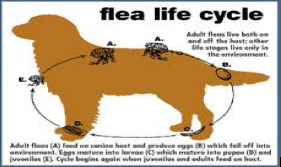 Flea Prevention
Flea Prevention
Physical Exam and Consultation / Preventive CareDiagnosis / Surgery / Dental Prophylaxis / Diets/Nutritional Counseling / Microchip / Flea Prevention / Heartworm Prevention
Flea Prevention- An Update
Fleas are small, brown or black, wingless, rapid-moving insects that feed on blood by biting pets and, occasionally, people. They can live without food for several months, but females must have a blood meal before they can produce eggs. They can deliver about 4000 eggs on the host's fur. The eggs go through four lifecycle stages: embryo, larva, pupa, and imago (adult).This whole life cycle from egg to adult takes from two to three weeks, although this depends on the temperature. It may take longer in cool conditions.

They can cause anemia, allergies and severe itching. Significant numbers of fleas can cause life threatening blood loss to young, elderly or debilitated pets.
Some dogs and cats develop a marked hypersensitivity to the saliva of fleas and experience intense itching which results in skin abrasions, hair loss, and secondary pyoderma . Fleas are also an intermediate host fortapeworms and If a pet ingests a flea during grooming, he or she could become infected with immature tapeworms that can be carried by fleas.
Flea infestation can be diagnosed by finding fleas on the dog or by seeing black-and-white, salt-and-pepper-like grains in the coat. These particles are flea feces (the “pepper”) and flea eggs (the “salt”). Fecal material is made up of digested blood. When brushed onto a wet paper, it turns a reddish brown.
Complete flea control consists of treating both the environment (including house and yard) and the pet. Ideally, fleas should be killed before they feed on the pet to reduce the potential for skin allergies and other health problems.
If you have questions about this or any medical topic, please call us at 905-575-0538 today.
